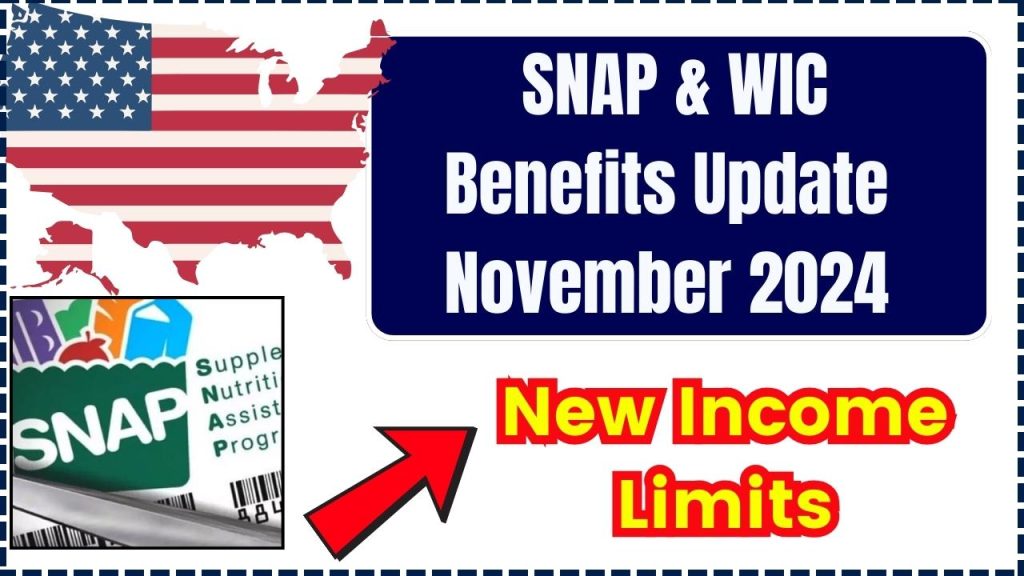November 2024 SNAP & WIC Benefits Update: The latest adjustments to the Supplemental Nutrition Assistance Program (SNAP) and the Special Supplemental Nutrition Program for Women, Infants, and Children (WIC) have introduced new income limits and eligibility requirements to better support Americans in need.
These programs play a pivotal role in ensuring food security for millions of households, and understanding the updated guidelines can help eligible families access the benefits they need. In this article, we’ll walk you through the latest changes, eligibility requirements, and practical advice on applying successfully.

Whether you’re a recipient, a social worker, or someone looking to understand how these programs work, this guide provides easy-to-follow information in a friendly yet authoritative tone.
November 2024 SNAP & WIC Benefits Update
| SNAP Gross Income Limits: Increased to 130% of the federal poverty level for most households. |
| WIC Eligibility: Updated income limits at 185% of the federal poverty level. |
| Resource Limits for SNAP: $2,750 in countable resources; $4,250 for elderly/disabled households. |
| Work Requirements for SNAP: Able-bodied adults aged 18-54 must meet work conditions to receive benefits. |
| Application Process: Varies by state, with online resources available. SNAP and WIC provide detailed guidance. |
Navigating SNAP and WIC can seem challenging, but understanding the 2024 updates on income limits and eligibility guidelines can ensure you or those you support receive the benefits they deserve. With increased income thresholds, adjusted asset limits, and clear work requirements, these updates are essential to keeping nutritious food within reach for those who need it most.
Overview of SNAP and WIC Programs
SNAP and WIC are both essential federal assistance programs, though they serve different populations with specific needs:
- SNAP provides food assistance to low-income individuals and families through an Electronic Benefits Transfer (EBT) card, accepted at most grocery stores.
- WIC serves pregnant, breastfeeding, and postpartum women, as well as infants and children under five. WIC benefits focus on providing nutritious foods, health education, and additional support like breastfeeding counselling.
Each year, these programs adjust their income limits to account for inflation and ensure adequate support for low-income households.
2024 SNAP Income Limits
To qualify for SNAP, households must meet gross and net income limits. Adjusted annually, these limits are based on the federal poverty level. Most households must keep their gross income (total income before deductions) at or below 130% of the poverty line, while net income should be at or below 100%.
Current SNAP Income Limits
| Household Size | Gross Monthly Income (130% of FPL) | Net Monthly Income (100% of FPL) |
|---|---|---|
| 1 | $1,580 | $1,215 |
| 2 | $2,137 | $1,644 |
| 3 | $2,694 | $2,072 |
| 4 | $3,250 | $2,500 |
| 5 | $3,807 | $2,929 |
| 6 | $4,364 | $3,357 |
| 7 | $4,921 | $3,785 |
| 8 | $5,478 | $4,214 |
| Each additional person | +$557 | +$429 |
Source: National Council on Aging (NCOA)
2024 WIC Income Guidelines
WIC guidelines, also updated annually, are set at 185% of the federal poverty level. The program supports specific low-income groups with a focus on young children and mothers, aiming to improve nutrition and health outcomes.
Current WIC Income Limits
| Household Size | Gross Annual Income Limit | Gross Monthly Income Limit |
|---|---|---|
| 1 | $27,861 | $2,322 |
| 2 | $37,814 | $3,152 |
| 3 | $47,767 | $3,981 |
| 4 | $57,720 | $4,810 |
| 5 | $67,673 | $5,640 |
| 6 | $77,626 | $6,469 |
| 7 | $87,579 | $7,299 |
| 8 | $97,532 | $8,128 |
| Each additional person | +$9,953 | +$830 |
Source: Louisiana WIC Program
Examples of Eligibility Scenarios
To illustrate, here are two examples of families that may or may not qualify:
- Example 1: A family of four with a gross monthly income of $3,200 and a net monthly income of $2,400 would qualify for SNAP, as they fall below the income limits for a household of their size.
- Example 2: A single pregnant woman earning $2,500 per month may qualify for WIC, but not SNAP, since her income exceeds SNAP’s gross limit for a single-person household.
These examples demonstrate how each program applies income standards based on household size and structure.
Impact of Updates on Recipients
The 2024 updates mean more families can now qualify for assistance due to the increased income thresholds. These adjustments are essential, as they help families cope with rising food costs and inflation.
For working professionals, this is an excellent opportunity to guide clients or community members toward resources that may be more accessible with the new income limits.
Additional SNAP and WIC Requirements
Resource Limits for SNAP
In addition to income limits, SNAP also has asset limits, which vary slightly depending on household composition. Countable resources (like bank accounts) must be below $2,750. However, if the household has an elderly or disabled member, the limit increases to $4,250.
Work Requirements for SNAP
Able-bodied adults aged 18-49 (now extended to age 54) without dependents are required to meet work criteria, including working or participating in a training program for at least 80 hours per month. Failing to meet these requirements could lead to a suspension of benefits after three months.
Apply for SNAP and WIC Benefits
Eligibility and application processes differ by state. Most states offer online application options, though you may also apply in person or by mail.
- SNAP Applications: The SNAP website provides information and links to state portals.
- WIC Applications: Visit the WIC website for state-specific information, including local WIC offices.
Common Mistakes to Avoid When Applying
- Overlooking Deductions: Many applicants forget to account for deductions (such as childcare expenses) that may reduce their net income and improve eligibility.
- Inaccurate Reporting: Ensure all income and household details are accurate; misreporting can delay the process.
- Missing Documentation: Have all required documents ready, including ID, proof of income, and residency verification, to avoid delays.
IRS Where’s My Refund? – IRS Refund Tracker, Refund Status @ irs.gov
Food Stamp Payment Schedule In November 2024 – State Wise SNAP Dates, Payment Amount
Social Security November Payment Update For Pre-1997 Retirees: Check Eligibility and Process
Additional Resources for Food and Health Assistance
Several other programs can supplement SNAP and WIC benefits:
- National School Lunch Program: Provides low-cost or free lunches to children in schools.
- Food Pantries and Banks: Local organizations offer emergency food assistance. Use resources like Feeding America to find food banks.
- Temporary Assistance for Needy Families (TANF): Helps low-income families achieve self-sufficiency with both cash and food benefits.
FAQs On November 2024 SNAP & WIC Benefits Update
1. Who qualifies for SNAP and WIC benefits?
SNAP assists all low-income individuals and families, while WIC focuses on pregnant and postpartum women and young children under five.
2. How are income limits determined?
Income limits for both programs are based on federal poverty levels, with SNAP using 130% and WIC using 185%.
3. Can I apply for both programs?
Yes, you can apply for both SNAP and WIC if you meet the respective eligibility criteria.
4. How long does it take to get approved?
Approval times vary by state and individual cases, but applicants typically hear back within 30 days. WIC approval may require a clinic visit.
5. Are there resources to help with applications?
Many states and community organizations offer assistance. Visit your local SNAP or WIC website or office for guidance.

